+ Open data
Open data
- Basic information
Basic information
| Entry | Database: PDB / ID: 6li3 | ||||||
|---|---|---|---|---|---|---|---|
| Title | cryo-EM structure of GPR52-miniGs-NB35 | ||||||
 Components Components |
| ||||||
 Keywords Keywords | MEMBRANE PROTEIN / G-protein coupled receptor / orphan GPCR / self-activation / cryo-EM | ||||||
| Function / homology |  Function and homology information Function and homology informationG protein-coupled photoreceptor activity / cellular response to light stimulus / PKA activation in glucagon signalling / developmental growth / hair follicle placode formation / phototransduction / D1 dopamine receptor binding / intracellular transport / vascular endothelial cell response to laminar fluid shear stress / renal water homeostasis ...G protein-coupled photoreceptor activity / cellular response to light stimulus / PKA activation in glucagon signalling / developmental growth / hair follicle placode formation / phototransduction / D1 dopamine receptor binding / intracellular transport / vascular endothelial cell response to laminar fluid shear stress / renal water homeostasis / activation of adenylate cyclase activity / Hedgehog 'off' state / adenylate cyclase-activating adrenergic receptor signaling pathway / cellular response to glucagon stimulus / regulation of insulin secretion / adenylate cyclase activator activity / trans-Golgi network membrane / locomotory behavior / negative regulation of inflammatory response to antigenic stimulus / G protein-coupled receptor activity / bone development / G-protein beta/gamma-subunit complex binding / platelet aggregation / Olfactory Signaling Pathway / cognition / Activation of the phototransduction cascade / G beta:gamma signalling through PLC beta / Presynaptic function of Kainate receptors / Thromboxane signalling through TP receptor / G protein-coupled acetylcholine receptor signaling pathway / G-protein activation / adenylate cyclase-activating G protein-coupled receptor signaling pathway / Activation of G protein gated Potassium channels / Inhibition of voltage gated Ca2+ channels via Gbeta/gamma subunits / Prostacyclin signalling through prostacyclin receptor / G beta:gamma signalling through CDC42 / Glucagon signaling in metabolic regulation / G beta:gamma signalling through BTK / Synthesis, secretion, and inactivation of Glucagon-like Peptide-1 (GLP-1) / ADP signalling through P2Y purinoceptor 12 / photoreceptor disc membrane / Sensory perception of sweet, bitter, and umami (glutamate) taste / Glucagon-type ligand receptors / Adrenaline,noradrenaline inhibits insulin secretion / Vasopressin regulates renal water homeostasis via Aquaporins / Glucagon-like Peptide-1 (GLP1) regulates insulin secretion / G alpha (z) signalling events / cellular response to catecholamine stimulus / ADP signalling through P2Y purinoceptor 1 / ADORA2B mediated anti-inflammatory cytokines production / G beta:gamma signalling through PI3Kgamma / sensory perception of smell / Cooperation of PDCL (PhLP1) and TRiC/CCT in G-protein beta folding / adenylate cyclase-activating dopamine receptor signaling pathway / GPER1 signaling / Inactivation, recovery and regulation of the phototransduction cascade / cellular response to prostaglandin E stimulus / G-protein beta-subunit binding / heterotrimeric G-protein complex / G alpha (12/13) signalling events / sensory perception of taste / extracellular vesicle / signaling receptor complex adaptor activity / Thrombin signalling through proteinase activated receptors (PARs) / positive regulation of cold-induced thermogenesis / retina development in camera-type eye / G protein activity / GTPase binding / Ca2+ pathway / fibroblast proliferation / High laminar flow shear stress activates signaling by PIEZO1 and PECAM1:CDH5:KDR in endothelial cells / G alpha (i) signalling events / G alpha (s) signalling events / phospholipase C-activating G protein-coupled receptor signaling pathway / G alpha (q) signalling events / Hydrolases; Acting on acid anhydrides; Acting on GTP to facilitate cellular and subcellular movement / Ras protein signal transduction / Extra-nuclear estrogen signaling / cell population proliferation / G protein-coupled receptor signaling pathway / response to xenobiotic stimulus / lysosomal membrane / GTPase activity / synapse / GTP binding / protein-containing complex binding / signal transduction / extracellular exosome / metal ion binding / membrane / plasma membrane / cytosol / cytoplasm Similarity search - Function | ||||||
| Biological species |  Homo sapiens (human) Homo sapiens (human) | ||||||
| Method | ELECTRON MICROSCOPY / single particle reconstruction / cryo EM / Resolution: 3.32 Å | ||||||
 Authors Authors | Li, M. / Wang, N. / Xu, F. / Wu, J. / Lei, M. | ||||||
 Citation Citation |  Journal: Nature / Year: 2020 Journal: Nature / Year: 2020Title: Structural basis of ligand recognition and self-activation of orphan GPR52. Authors: Xi Lin / Mingyue Li / Niandong Wang / Yiran Wu / Zhipu Luo / Shimeng Guo / Gye-Won Han / Shaobai Li / Yang Yue / Xiaohu Wei / Xin Xie / Yong Chen / Suwen Zhao / Jian Wu / Ming Lei / Fei Xu /   Abstract: GPR52 is a class-A orphan G-protein-coupled receptor that is highly expressed in the brain and represents a promising therapeutic target for the treatment of Huntington's disease and several ...GPR52 is a class-A orphan G-protein-coupled receptor that is highly expressed in the brain and represents a promising therapeutic target for the treatment of Huntington's disease and several psychiatric disorders. Pathological malfunction of GPR52 signalling occurs primarily through the heterotrimeric G protein, but it is unclear how GPR52 and G couple for signal transduction and whether a native ligand or other activating input is required. Here we present the high-resolution structures of human GPR52 in three states: a ligand-free state, a G-coupled self-activation state and a potential allosteric ligand-bound state. Together, our structures reveal that extracellular loop 2 occupies the orthosteric binding pocket and operates as a built-in agonist, conferring an intrinsically high level of basal activity to GPR52. A fully active state is achieved when G is coupled to GPR52 in the absence of an external agonist. The receptor also features a side pocket for ligand binding. These insights into the structure and function of GPR52 could improve our understanding of other self-activated GPCRs, enable the identification of endogenous and tool ligands, and guide drug discovery efforts that target GPR52. | ||||||
| History |
|
- Structure visualization
Structure visualization
| Movie |
 Movie viewer Movie viewer |
|---|---|
| Structure viewer | Molecule:  Molmil Molmil Jmol/JSmol Jmol/JSmol |
- Downloads & links
Downloads & links
- Download
Download
| PDBx/mmCIF format |  6li3.cif.gz 6li3.cif.gz | 195.4 KB | Display |  PDBx/mmCIF format PDBx/mmCIF format |
|---|---|---|---|---|
| PDB format |  pdb6li3.ent.gz pdb6li3.ent.gz | 153.3 KB | Display |  PDB format PDB format |
| PDBx/mmJSON format |  6li3.json.gz 6li3.json.gz | Tree view |  PDBx/mmJSON format PDBx/mmJSON format | |
| Others |  Other downloads Other downloads |
-Validation report
| Summary document |  6li3_validation.pdf.gz 6li3_validation.pdf.gz | 876.4 KB | Display |  wwPDB validaton report wwPDB validaton report |
|---|---|---|---|---|
| Full document |  6li3_full_validation.pdf.gz 6li3_full_validation.pdf.gz | 885 KB | Display | |
| Data in XML |  6li3_validation.xml.gz 6li3_validation.xml.gz | 33 KB | Display | |
| Data in CIF |  6li3_validation.cif.gz 6li3_validation.cif.gz | 49.3 KB | Display | |
| Arichive directory |  https://data.pdbj.org/pub/pdb/validation_reports/li/6li3 https://data.pdbj.org/pub/pdb/validation_reports/li/6li3 ftp://data.pdbj.org/pub/pdb/validation_reports/li/6li3 ftp://data.pdbj.org/pub/pdb/validation_reports/li/6li3 | HTTPS FTP |
-Related structure data
| Related structure data |  0902MC  6li0C  6li1C  6li2C C: citing same article ( M: map data used to model this data |
|---|---|
| Similar structure data |
- Links
Links
- Assembly
Assembly
| Deposited unit | 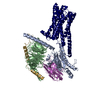
|
|---|---|
| 1 |
|
- Components
Components
| #1: Protein | Mass: 39128.777 Da / Num. of mol.: 1 / Mutation: A130W, C314P Source method: isolated from a genetically manipulated source Source: (gene. exp.)  Homo sapiens (human) / Gene: GPR52 / Production host: Homo sapiens (human) / Gene: GPR52 / Production host:  |
|---|---|
| #2: Protein | Mass: 28907.684 Da / Num. of mol.: 1 Source method: isolated from a genetically manipulated source Source: (gene. exp.)  Homo sapiens (human) / Gene: GNAS, GNAS1, GSP / Plasmid: pET15b / Production host: Homo sapiens (human) / Gene: GNAS, GNAS1, GSP / Plasmid: pET15b / Production host:  |
| #3: Protein | Mass: 37416.930 Da / Num. of mol.: 1 Source method: isolated from a genetically manipulated source Source: (gene. exp.)  Homo sapiens (human) / Gene: GNB1 / Production host: Homo sapiens (human) / Gene: GNB1 / Production host:  |
| #4: Protein | Mass: 7845.078 Da / Num. of mol.: 1 Source method: isolated from a genetically manipulated source Source: (gene. exp.)  Homo sapiens (human) / Gene: GNG2 / Production host: Homo sapiens (human) / Gene: GNG2 / Production host:  |
| #5: Antibody | Mass: 16054.232 Da / Num. of mol.: 1 Source method: isolated from a genetically manipulated source Source: (gene. exp.)   |
| Has protein modification | Y |
-Experimental details
-Experiment
| Experiment | Method: ELECTRON MICROSCOPY |
|---|---|
| EM experiment | Aggregation state: PARTICLE / 3D reconstruction method: single particle reconstruction |
- Sample preparation
Sample preparation
| Component |
| ||||||||||||||||||||||||
|---|---|---|---|---|---|---|---|---|---|---|---|---|---|---|---|---|---|---|---|---|---|---|---|---|---|
| Source (natural) |
| ||||||||||||||||||||||||
| Source (recombinant) |
| ||||||||||||||||||||||||
| Buffer solution | pH: 7.5 | ||||||||||||||||||||||||
| Specimen | Embedding applied: NO / Shadowing applied: NO / Staining applied: NO / Vitrification applied: YES | ||||||||||||||||||||||||
| Vitrification | Cryogen name: ETHANE |
- Electron microscopy imaging
Electron microscopy imaging
| Experimental equipment |  Model: Titan Krios / Image courtesy: FEI Company |
|---|---|
| Microscopy | Model: FEI TITAN KRIOS |
| Electron gun | Electron source:  FIELD EMISSION GUN / Accelerating voltage: 300 kV / Illumination mode: FLOOD BEAM FIELD EMISSION GUN / Accelerating voltage: 300 kV / Illumination mode: FLOOD BEAM |
| Electron lens | Mode: BRIGHT FIELD |
| Image recording | Electron dose: 40 e/Å2 / Film or detector model: FEI FALCON III (4k x 4k) |
- Processing
Processing
| CTF correction | Type: PHASE FLIPPING AND AMPLITUDE CORRECTION |
|---|---|
| 3D reconstruction | Resolution: 3.32 Å / Resolution method: FSC 0.143 CUT-OFF / Num. of particles: 651465 / Symmetry type: POINT |
 Movie
Movie Controller
Controller



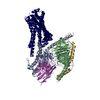
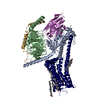
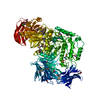
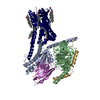
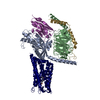
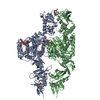

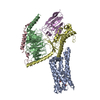
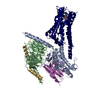
 PDBj
PDBj























